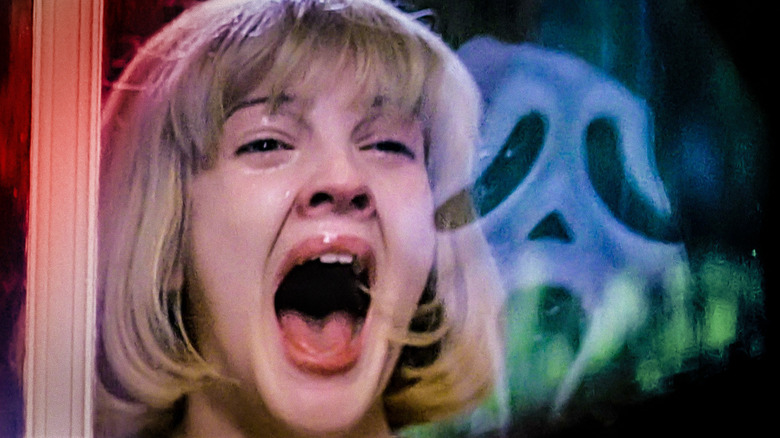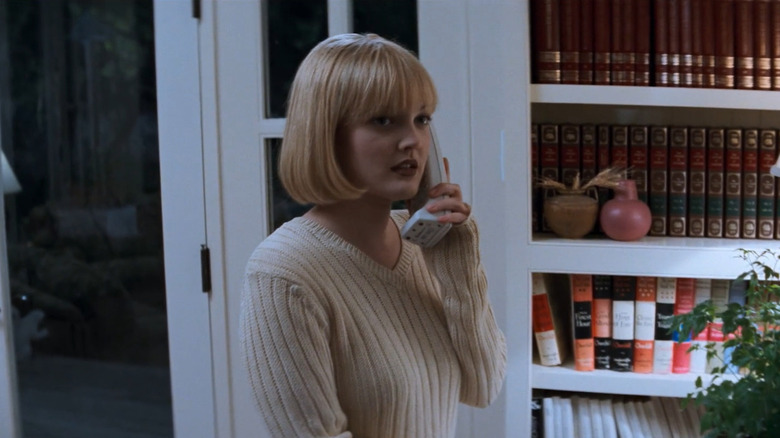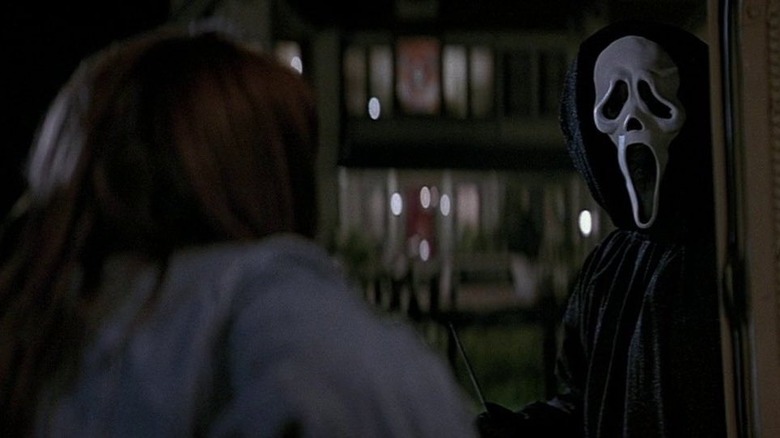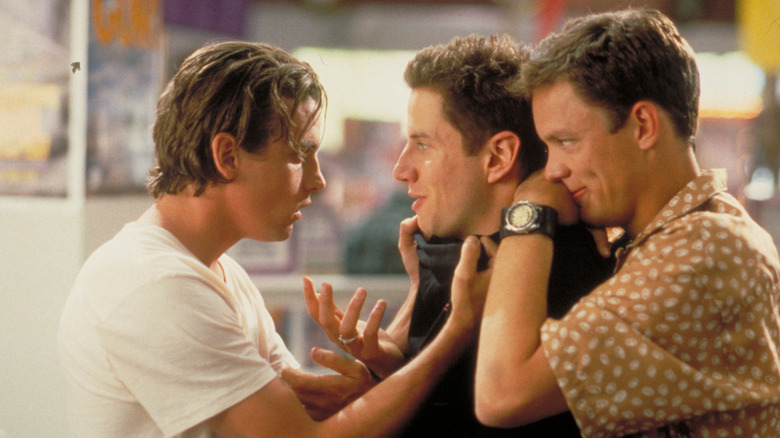Tales From The Box Office: How Wes Craven's Scream Saved The Slasher Genre
(Welcome to Tales from the Box Office, our column that examines box office miracles, disasters, and everything in between, as well as what we can learn from them.)
Horror is truly one of the mainstay staples of Hollywood and, in many ways, its ever-reliable backbone. Slasher flicks, specifically, feel as though they have always done particularly well. It's a genre where an investment of a few million dollars can eventually lead to the "Halloween" franchise taking in over $700 million at the global box office. It's a space where Jason Voorhees can go from being a footnote in the original "Friday the 13th" to becoming a globally recognized icon of cinema who has also generated hundreds of millions of dollars.
Yet, there was a time in the '90s when the slasher genre was all but dead, representing but a shadow of its former self. Then Wes Craven came along with "Scream" in 1996 and not only revitalized his career, but reinvented the genre as we know it.
With a brand new "Scream" now in theaters — the fifth overall in the franchise and, sadly, the first not to be directed by Craven as he passed away in 2015 – now seems like the perfect time to take a look back at the original 90s horror classic that started it all. We're going to look at how the original "Scream" came to be, how it defied the odds to become an all-time smash horror hit, and how it revived a seemingly dead genre in ways nobody could have possibly imagined.
The Movie: Scream
In 1995, a young screenwriter by the name of Kevin Williamson had shopped around a script titled "Scary Movie" (later used as the title of a series of spoof films based on the success of "Scream") that had been labeled as "pitch-perfect," ultimately to be purchased by Dimension Films following a bidding war. Wes Craven, who previously created Freddy Krueger and the "A Nightmare On Elm Street" franchise, had been approached to direct "Scream" but repeatedly passed. As the story goes, Craven didn't want to do another horror movie, despite the fact that everyone loved the script. Ultimately (and very fortunately) he was convinced otherwise and signed onto the project.
The casting of "Scream" was a journey unto itself. Originally, Drew Barrymore signed on to play the lead role of Sidney Prescott, which was eventually played by Neve Campbell. Instead, Barrymore plays Casey Becker, who is brutally slaughtered by the mysterious killer in a ghost mask (later dubbed "Ghostface") in the film's opening minutes. This decision, in itself, paved the way for the success of "Scream," as it served as a major surprise to audiences who assumed that Barrymore's character would have a big role to play. In a roundabout way, she did: Casey's death made it clear that nobody was safe.
Joining Campbell would be the likes of David Arquette as Dewey Riley, Courteney Cox as reporter Gale Weathers, Rose McGowan as Tatum, Jamie Kennedy as the meta horror expert Randy, Skeet Ulrich as Sidney's boyfriend Billy, and Matthew Lillard as fan-favorite Stuart. Randy and Stu were revealed to be the killers in a twist on a twist, with two people serving as the man behind the mask. The mix of familiar and fresh faces proved to be a major ingredient in this movie's secret sauce, right alongside Williamson's page-turner of a script.
With a relatively healthy budget of $15 million, "Scream" came together and was shot between April and June of 1996, making for a quick turnaround, as it would end up being released in theaters later that year. Oddly enough, it was timed around the Christmas holiday frame rather than Halloween. Be that as it may, everything came together in a big, bad, bloody good way.
The Financial Journey
"Scream" debuted in theaters on December 20, 1996, and, quite frankly, didn't make a huge impact, taking in just $6.3 million on its opening weekend. But the buzz and word of mouth proved to be too much to contain, leading to a second weekend haul of $9 million. And it just kept going from there. In the end, the film finished with $103 million domestic (which is astonishing considering that low opening), en route to $173 million worldwide. Considering the budget, that is downright amazing. "Scream 2" would go on to make an impressive $172 million globally in 1997, with "Scream 3" doing $161 million worth of business in 2000. "Scream 4," released in 2011, did a respectable $95 million. All told, it's one of the highest-grossing horror franchises in history with a collective box office total of $603 million (and counting).
But the real legacy left behind by Craven's slasher pic is that it revived the slasher genre at a time when it was about as dead as it's ever been. While horror boomed in the '80s with "Friday the 13th" and everything that followed, things cooled off big time by the mid-'90s, with the sequels in these franchises (particularly "Halloween") doing progressively less impressive business, and original slashers relegated to home video or fighting for scraps.
Leave it to Wes Craven to come to the rescue; "Scream" put slashers back on the map. In the years that followed, we got "Halloween: H20," which brought Jamie Lee Curtis back to the series and earned $55 million domestic, as well as "Bride of Chucky," which brought the killer doll back to the big screen and earned $50 million. We also get new, original movies such as "Urban Legend" ($72 million) and "I Know What You Did Last Summer" ($125 million), both of which started brand new franchises. Not only that, the home video market was far more robust back then, meaning that the earnings didn't stop at the box office. Because these movies continued to do well, this trend continued into the 2000s, helping to pave the way for movies like "Jason X" (Jason in space, baby!), "Wrong Turn," and arguably even the "Final Destination" series.
Yes, "Scream," unto itself, is a gigantic moneymaker and a beloved franchise, but it also enabled lots of other studios and filmmakers to piggyback off of its success, leading to a string of box office hits (as well as flops) that were all attempting to get in on the revived slasher craze.
The Lessons Contained Within
It would have been very easy in 1995 for a studio to say "slashers aren't working right now" and either rework Williamson's script entirely, or just say no to the movie and be done with it. But sometimes a leap of faith in the direction of a good idea is the way to go. Hollywood, due to the nature of the beast, is always going to be risky. Sometimes though, that risk is well worth taking, as was the case with "Scream." Executives in positions to make big decisions would do well to, in a calculated fashion, be willing to take those risks when a script like this comes across their desk. Granted, that doesn't happen every day, but when that day comes, imagine if they just said "pass" and the script for what was once called "Scary Movie" never got made?
This is different from, say, Disney investing $250 million in a "Lone Ranger" movie in the hopes of starting another franchise like "Pirates of the Caribbean," or looking at "John Carter" and thinking that was a great investment because people like big sci-fi movies. That is old, boring thinking that gets people in trouble. To that end, both of those movies bombed in spectacular fashion (something we'll likely cover in another edition of this very column) and there are countless stories like it from every studio in town. Chasing trends is necessary but can be dangerous and it leads to irresponsible spending.
Rather, especially in the age of streaming when it can be so very difficult to stand out, studios and streamers should be more willing than ever to take calculated risks on good ideas that are in a budget range where things make sense. Yes, when we get to the $150 million tentpole range, things get challenging. But what's nice about the genre space is that it allows for invention because movies don't have to cost that much. Hell, they can be made on shoestring budgets in many cases. Look what Blumhouse manages to accomplish by keeping budgets low and allowing filmmakers to explore unique ideas. That's how we wind up with "Get Out." That's how "The Purge" franchise happens. That's how M. Night Shyamalan makes his comeback.
In "Scream," there is a big lesson in the nature of movies being a healthy intersection of art vs. entertainment, and not turning your nose up when just such an intersection of those ideas presents itself, even if it's not necessarily trendy in that moment. The upside is too great.



